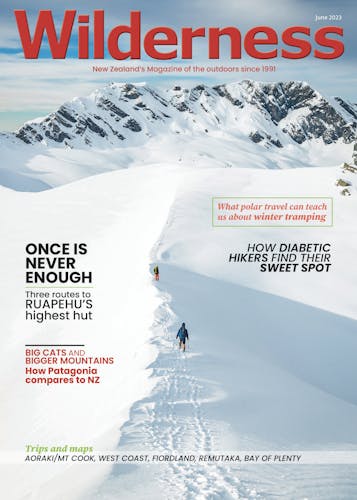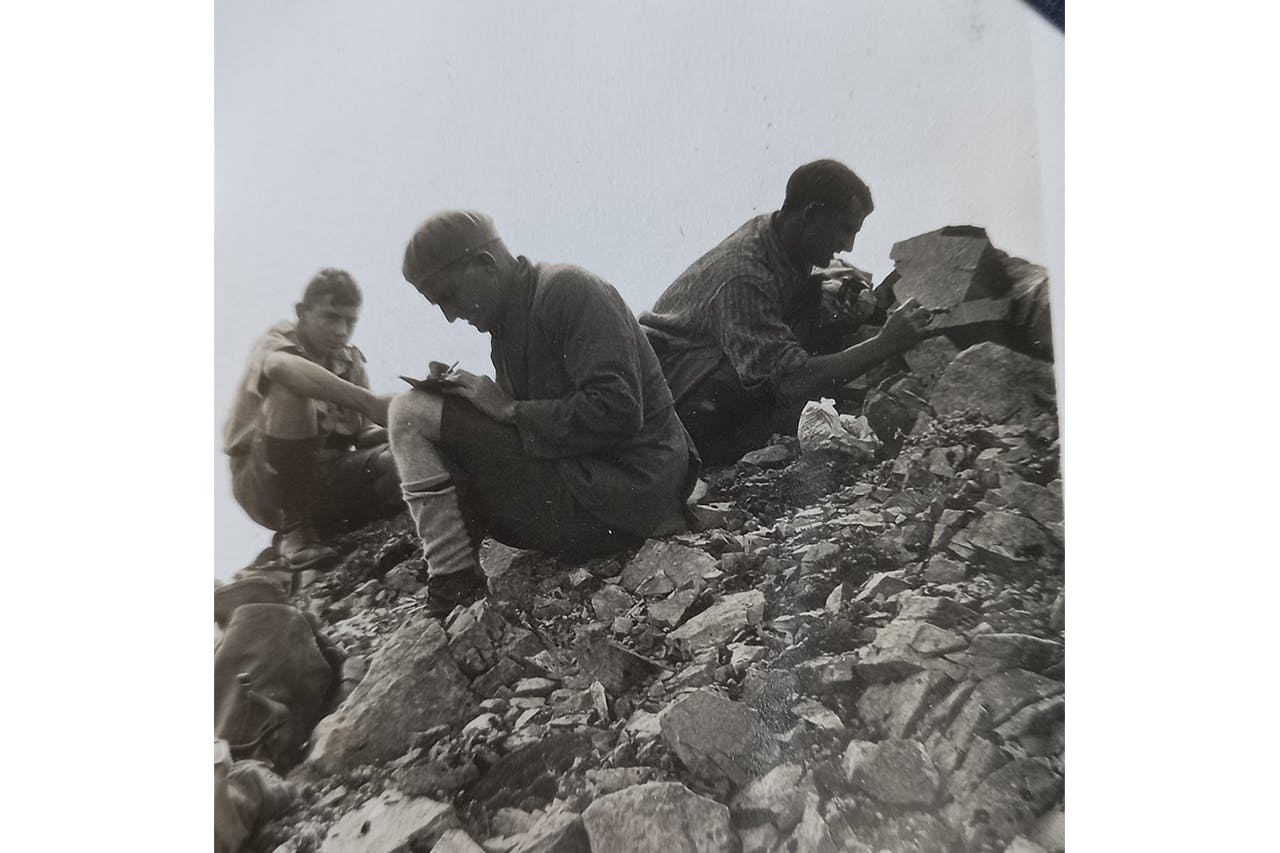Letter of the month
How to ensure TA’s sustainability
In ‘Te Araroa Trail shows pressure’ (May 2023), Imogen Coxhead focused on questions of overcrowding and sustainability.
My wife and I took on the TA in sections and have recently completed it. We began before the trail was fully established. In the early stages, we rarely encountered other walkers. In the few years pre-Covid, numbers increased noticeably and this season, Matt Claridge, Te Araroa Trust executive director, stated there had been ‘around 4000 walkers’, the majority being young Europeans.
Few walked the entire length of the trail. Many sections were skipped, particularly in the North Island. Blogs and chat groups indicate greater interest in the South Island and, increasingly, in walking the South Island northbound.
TA has been a tribute to the vision and energy that (originator) Geoff Chapple provided together with willing and generous volunteers. But now it is becoming a victim of its own success. Present trends suggest that walker numbers will grow with a disproportionate increase in pressure on the South Island. The TA Trust is aware of these challenges and its Strategic Plan is comprehensive, encompassing infrastructure and sustainability. Many of the most stressed areas are administered by DOC, which doesn’t seem to have adequate resources for maintenance and improvements.
Should the TA simply grow unchecked to find its own level of sufficient regional support, or can more strategic investment be provided? Resourcing is an issue. Simple campsite solutions and prioritisation of maintenance, repair (or retirement) of some sections could be considered and affordable in the short term. Substantial funding, though, is required for some seriously degraded sections. More open discussion should assist the trust so the long-term character, success and sustainability of this unique and widely appreciated trail is ensured.
– Norman Sharpe

Norman receives a Ledlenser HR5 Core worth $199.99 from www.ledlenser.co.nz. Readers, send your letter to the editor for a chance to win.
That family connection
‘The secret life of rock cairns’ (May 2023) interested me. The family connection (Claire and Hugh Bibby are my cousins) prompted me to find my father’s photo album. I knew that my father (Ron Bibby) had recorded two trips into the Ruahines in 1929 and 1930. The photo above was taken on the 1929 trip and shows two of his brothers, Hugh and Basil, with a friend Jack Baker, writing notes to leave in the cairn on Rangioteatua.
– Neville Bibby
Te Araroa fixes
The high number of walkers affecting infrastructure on Te Araroa will be an ongoing issue. There is nothing stopping 20,000 people setting out, apart from feedback about unpleasant overcrowding and degraded facilities. A proper funding system should be developed to deal with the popularity of the trail.
Upgrading and renewing huts to cope with uncontrolled occupation may not be sustainable or warranted. I’ve completed the TA northbound, and thought about facilities that worked and possible simple improvements.
At huts without a stream, drinking water is important. We visited huts with barely any water storage. How about plain open-sided cooking shelters that collect rainwater plus ample storage where it’s needed?
I think camping should be encouraged. Some hut sites had this arrangement, but few had enough water storage. Simple picnic tables outside made a big difference to comfort and conviviality when camping, and they were appreciated.
Pirongia starred as a camping experience. There is a shelter with water and a sink, and landscaped tent sites closely surrounded by natural hedging. No need to stay in the full and noisy hut, even when it’s raining.
Toilets are a harder problem. Extra toilets are needed only for a short season, when most TA walkers move through. Maybe portable long drops could be flown in and out of sensitive areas, or left but mostly closed in the off-season to reduce servicing.
I hope such challenges can be resolved, as the TA is an incredible journey.
– Jo Halley
Biting the bullet
I finally signed up to Walk1200km. Our family have been Wilderness subscribers for a few years and I’ve looked at the challenge and all the photos and stories and thought I didn’t need to sign up because I probably walk that distance anyway.
Our family are keen trampers. We aim to do a Great Walk each year, and I do try to keep fit; I’ve managed a couple of marathons and triathlons. But here I am, sitting at home with the weather starting to close in for winter, Covid positive (round 2), reading the May issue and the motivation to exercise is staring at me from the pages.
So, I’ve signed up. Now to get off the couch. I know I always feel better post-walk. I’m intrigued to see how many kilometres I can rack up in a year and it will be a good excuse to replace my shoes a bit more often!
– Janine Devaney
Thriving outdoors
I read the article ‘Women thriving outdoors’ (May 2023) with interest and have plenty of admiration for the adventurous women profiled.
I identified with feeling less confident and often less physically capable than most men, but at present I am enjoying tramping with a wonderful group of supportive companions from the Geraldine Tramping Club. We are a diverse group – men and women, experienced and new to tramping, with varying degrees of fitness.
In recent years, active membership is mostly women over fifty, many having taken up tramping in their retirement.
I have tramped since I was a teenager, and think older women are drawn to this form of recreation by a desire to keep healthy and fit and to spend time in the backcountry enjoying the company of like-minded friends.
It’s wonderful that so many older women are getting out tramping and ‘thriving outdoors’.
– Charlotte Woods
A common error
The story ‘Fungi on the track’ (May 2023) calls for comment. It stated, ‘… it is endemic to New Zealand and can only be found here’. You have just said the same thing twice in one sentence.
The author also put ‘only’ in the wrong place – a common error. It is not the finding that ‘only’ refers to – the fungus can also be photographed, sketched or collected – but where it is found: ‘only in New Zealand’. The rules of grammar state that ‘only’ goes next to the word it modifies.
Better would have been either ‘it is endemic to New Zealand’ or ‘it is found only in New Zealand’.
– Tony Williams
– Thanks Tony! No mistake is acceptable in the magazine, though they do creep in. Your comment brings to mind the time we captioned a red crab as ‘red crap’. That one lost us a subscriber. Hopefully, you’ll stick around!
– AH
Good times as DOC hosts
What a privilege to be DOC hosts recently in the Marlborough Sounds. My wife and I had a rewarding time welcoming thru-hikers, day trampers and cyclists.
The department wins as its interests are advantageously represented. Trampers win by receiving friendly local advice and encouragement. And hosts win by having a two-week break.
On the way to our location by boat, we experienced bottlenose dolphins close up. Early one morning I watched the interplay between a shag and heron catching fish together. A David Attenborogh-quality moment that I will never forget.
I would encourage anyone with an interest in conservation to contact their local DOC office to see what locations are available for hosting.
– Rex Hunt
Bagging a bed in Rakiura
In March, three friends and I from the New Plymouth Tramping Club walked the Rakiura North West Circuit. We swam each day on the 10 day trip and loved the surf beaches and golden sands. We also delighted in the hills, the bush and the isolation. On a side trip up Mt Anglem, we laughed in the face of gales, hail and snow flurries. Climbing Rocky Mountain we were thrilled to see a kiwi throw back its head, open its beak wide, and call to its mate. Magic.
We shared the huts with overseas and locals, hunters and fishermen; friendly people. It was a surprise how busy the huts were. A bigger shock was getting back to Oban and finding no beds available anywhere. Luckily we were helped by people we’d met in a hut. DOC informed us it’s like that up to the end of April. So book your Oban stay before you get there.
– Keith Coughtrey








